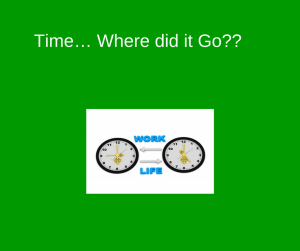 Part 1 –Time Management – It’s a Family Affair!
Part 1 –Time Management – It’s a Family Affair!- Part 2 – Time… Where did it Go??
- Part 3 – Time for Reflection on Time
By Cindy Goldrich, Ed.M., ACAC
A Sense of Time is a developmental skill. Children, especially those with ADHD, do not have the same mastery of time that adults do. They may have difficulty judging and anticipating the true amount of time it takes to accomplish tasks – big or small. Also, many children, again especially those with ADHD, have difficulty transitioning from one activity to the next. They may become so attached to their current activity that they feel unable to pull themselves away.
Here are some basic tips that might be helpful:
- Do some time estimation exercises.
- For one week, see how accurate you and your children are at predicting how long a given activity actually takes. Use a clock or timer to see time move as you complete a task. Try playing beat the clock just to raise their interest in looking at time as a factor in what they do. You can use the Task Time Estimation – Estimated Vs. Actual handout. Estimate the time REALLY needed for getting ready in the morning, eating a meal, doing laundry, reading 15 pages, completing a math sheet, etc. For younger children ask them to predict how long getting dressed or cleaning their room might take and then see how long it actually takes.
- Another way to look at Time is to see how much of it is already committed vs. having time for unplanned or unscheduled events. Simply write down how much time is needed for all the things you MUST do each day (eat, sleep, get dressed, homework, etc.) and add it up. Then subtract that time from 24 hours and you will see what time is available for everything else.
- Plan to allow for extra time so there is no need to rush.
It is less stressful, especially for some children, to arrive a few minutes early and allow time for adjustment to the new setting (even if a familiar one) then to arrive barely on time or a few minutes late.
5. Give advance notice about what you will be doing next and when it will be happening.
“We’ll be eating dinner in 15 minutes, so begin cleaning up.”
“We’ll be leaving for school in 5 minutes, check to make sure you have done your morning tasks.”
Remember to use a timer so You are not the nag!!
Especially for younger children or those who have an especially difficult time with transitions, try this: Join in their activity for the final few minutes so you can help them transition. Rather than insisting on an abrupt departure, spend even one or two minutes down at your child’s level and help them make the transition.
“Dani, I see you really like playing with Paige, how about we make plans for next week to do this again.”
“Jordan, I see you are getting even higher on that game. Tomorrow will you show me how you got to that part?”
Transitioning won’t always be smooth, but you are teaching a skill and helping stay calm.
6. Take an extra moment and breathe. Sometimes, when children have trouble disengaging from an activity, we have a tendency to get frustrated and perhaps panic about the pending struggle and about being late to the next appointment. Panic and Pressure won’t budge your child. It might even prolong the process.
- Part 1 –Time Management – It’s a Family Affair! – Valuable Systems are the Keys to Good Time Management
- Part 2 – Time… Where did it Go??
- Part 3 – Time for Reflection on Time
Written by Cindy Goldrich, Ed.M., ACAC © 2013 PTS Coaching. All rights reserved. Articles may be reproduced or electronically distributed as long as attribution to PTS Coaching is maintained. Original post: Time Management – It’s a Family Affair!
“Image courtesy of renjith krishnan/FreeDigitalPhoto.net” Modified on Canva.com
Follow ADHD – ADD’s board Productivity and Time Management on Pinterest.


